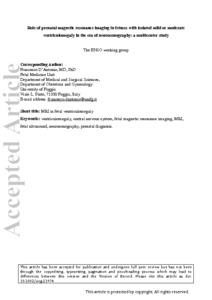ENSO working group
(2020)
Role of prenatal magnetic resonance imaging in fetuses with isolated mild or moderate ventriculomegaly in the era of neurosonography: international multicenter study.
Ultrasound Obstet Gynecol, 56 (3).
pp. 340-347.
ISSN 1469-0705
https://doi.org/10.1002/uog.21974
SGUL Authors: Thilaganathan, Baskaran Khalil, Asma
![[img]](https://openaccess.sgul.ac.uk/111939/1.hassmallThumbnailVersion/uog.21974.pdf)  Preview |
|
PDF
Accepted Version
Available under License ["licenses_description_publisher" not defined].
Download (260kB)
| Preview
|
Abstract
Objectives
To assess the role of fetal magnetic resonance imaging (MRI) in detecting associated anomalies in fetuses presenting with mild or moderate isolated ventriculomegaly (VM) undergoing multiplanar ultrasound evaluation of the fetal brain.
Methods
This was a multicenter, retrospective, cohort study involving 15 referral fetal medicine centers in Italy, the UK and Spain. Inclusion criteria were fetuses affected by isolated mild (ventricular atrial diameter, 10.0–11.9 mm) or moderate (ventricular atrial diameter, 12.0–14.9 mm) VM on ultrasound, defined as VM with normal karyotype and no other additional central nervous system (CNS) or extra‐CNS anomalies on ultrasound, undergoing detailed assessment of the fetal brain using a multiplanar approach as suggested by the International Society of Ultrasound in Obstetrics and Gynecology guidelines for the fetal neurosonogram, followed by fetal MRI. The primary outcome of the study was to report the incidence of additional CNS anomalies detected exclusively on prenatal MRI and missed on ultrasound, while the secondary aim was to estimate the incidence of additional anomalies detected exclusively after birth and missed on prenatal imaging (ultrasound and MRI). Subgroup analysis according to gestational age at MRI (< 24 vs ≥ 24 weeks), laterality of VM (unilateral vs bilateral) and severity of dilatation (mild vs moderate VM) were also performed.
Results
Five hundred and fifty‐six fetuses with a prenatal diagnosis of isolated mild or moderate VM on ultrasound were included in the analysis. Additional structural anomalies were detected on prenatal MRI and missed on ultrasound in 5.4% (95% CI, 3.8–7.6%) of cases. When considering the type of anomaly, supratentorial intracranial hemorrhage was detected on MRI in 26.7% of fetuses, while polymicrogyria and lissencephaly were detected in 20.0% and 13.3% of cases, respectively. Hypoplasia of the corpus callosum was detected on MRI in 6.7% of cases, while dysgenesis was detected in 3.3%. Fetuses with an associated anomaly detected only on MRI were more likely to have moderate than mild VM (60.0% vs 17.7%; P < 0.001), while there was no significant difference in the proportion of cases with bilateral VM between the two groups (P = 0.2). Logistic regression analysis showed that lower maternal body mass index (adjusted odds ratio (aOR), 0.85 (95% CI, 0.7–0.99); P = 0.030), the presence of moderate VM (aOR, 5.8 (95% CI, 2.6–13.4); P < 0.001) and gestational age at MRI ≥ 24 weeks (aOR, 4.1 (95% CI, 1.1–15.3); P = 0.038) were associated independently with the probability of detecting an associated anomaly on MRI. Associated anomalies were detected exclusively at birth and missed on prenatal imaging in 3.8% of cases.
Conclusions
The incidence of an associated fetal anomaly missed on ultrasound and detected only on fetal MRI in fetuses with isolated mild or moderate VM undergoing neurosonography is lower than that reported previously. The large majority of these anomalies are difficult to detect on ultrasound. The findings from this study support the practice of MRI assessment in every fetus with a prenatal diagnosis of VM, although parents can be reassured of the low risk of an associated anomaly when VM is isolated on neurosonography.
| Item Type: |
Article
|
| Additional Information: |
This is the peer reviewed version of the following article: (2020), Role of prenatal magnetic resonance imaging in fetuses with isolated mild or moderate ventriculomegaly in the era of neurosonography: international multicenter study. Ultrasound Obstet Gynecol, 56: 340-347, which has been published in final form at https://doi.org/10.1002/uog.21974. This article may be used for non-commercial purposes in accordance with Wiley Terms and Conditions for Use of Self-Archived Versions. |
| Keywords: |
MRI, central nervous system, fetal magnetic resonance imaging, fetal ultrasound, neurosonography, prenatal diagnosis, ventriculomegaly, ENSO working group, 1114 Paediatrics and Reproductive Medicine, Obstetrics & Reproductive Medicine |
| SGUL Research Institute / Research Centre: |
Academic Structure > Molecular and Clinical Sciences Research Institute (MCS) |
| Journal or Publication Title: |
Ultrasound Obstet Gynecol |
| ISSN: |
1469-0705 |
| Language: |
eng |
| Publisher License: |
Publisher's own licence |
| PubMed ID: |
31917496 |
| Dates: |
| Date |
Event |
| 2020-09-01 |
Published |
| 2020-01-09 |
Published Online |
| 2019-12-20 |
Accepted |
|
 |
Go to PubMed abstract |
| URI: |
https://openaccess.sgul.ac.uk/id/eprint/111939 |
| Publisher's version: |
https://doi.org/10.1002/uog.21974 |
Statistics
Item downloaded times since 11 May 2020.
Actions (login required)
 |
Edit Item |



